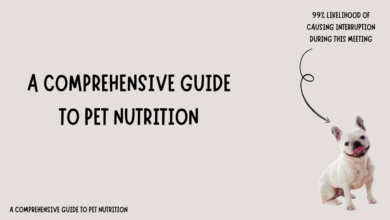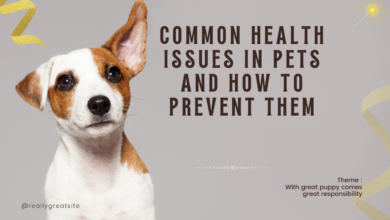
Managing your pet’s weight is crucial for their overall health and well-being. Obesity in pets can lead to a range of health problems, including diabetes, heart disease, joint issues, and a reduced quality of life. Just as with humans, maintaining a healthy weight is key to preventing these issues and ensuring a long, happy life for your pet. This article will guide you through the steps necessary to manage your pet’s weight effectively and promote optimal health.
Understanding Pet Obesity
Pet obesity is a growing concern among veterinarians and pet owners alike. It’s generally defined as having excess body fat that negatively impacts your pet’s health. Obesity can result from an imbalance between the calories consumed and the calories expended.

Common contributing factors include overfeeding, lack of exercise, and certain medical conditions.
- Causes of Obesity:
- Overfeeding: Feeding pets more than they need, often due to giving excessive treats or not measuring food portions correctly.
- Lack of Exercise: Pets that do not get enough physical activity are more likely to gain weight. Indoor pets, in particular, may be at risk.
- Medical Conditions: Some health issues, such as hypothyroidism or Cushing’s disease, can contribute to weight gain.
- Breed Predispositions: Certain breeds are more prone to obesity due to their metabolism or genetic factors.
- Health Risks Associated with Obesity:
- Diabetes Mellitus: Excess body fat can lead to insulin resistance, increasing the risk of diabetes.
- Joint Problems: Extra weight puts additional stress on joints, leading to arthritis and mobility issues.
- Heart Disease: Obesity can strain the heart and lead to cardiovascular problems.
- Reduced Life Expectancy: Obese pets may have a shorter lifespan due to the increased risk of severe health conditions.
Assessing Your Pet’s Weight
Before implementing a weight management plan, it’s essential to assess your pet’s current weight and body condition. Veterinarians often use a Body Condition Score (BCS) system to evaluate whether a pet is underweight, ideal weight, or overweight.
- Body Condition Score (BCS):
- 1-3: Underweight. Ribs, spine, and pelvic bones are easily visible. Minimal fat cover.
- 4-5: Ideal weight. Ribs are palpable with a slight fat cover. Waist is visible when viewed from above.
- 6-9: Overweight to obese. Ribs are difficult to feel due to excessive fat cover. Abdomen is rounded and has no visible waist.
- Consulting a Veterinarian: Your veterinarian can help determine your pet’s ideal weight and create a tailored weight management plan. They can also rule out any underlying medical conditions contributing to weight gain.
Creating a Weight Management Plan
A successful weight management plan includes a combination of dietary adjustments, increased physical activity, and regular monitoring. Here’s how to implement an effective plan:
- Dietary Adjustments:
- Portion Control: Measure your pet’s food to ensure they are getting the right amount. Avoid free-feeding, where food is available at all times.
- Balanced Diet: Provide a high-quality, nutritionally balanced diet that meets your pet’s specific needs. Consult your veterinarian for recommendations on appropriate food types and brands.
- Healthy Treats: Limit treats and choose low-calorie, healthy options. Treats should not make up more than 10% of your pet’s daily caloric intake.
- Slow Feeding: Use puzzle feeders or slow-feed bowls to help your pet eat more slowly and feel fuller longer.
- Increasing Physical Activity:
- Regular Exercise: Incorporate daily walks, playtime, and interactive toys to increase your pet’s activity level. The type and amount of exercise will depend on your pet’s age, breed, and fitness level.
- Interactive Play: Engage in activities that stimulate both mental and physical exercise. For dogs, consider fetch or agility training. For cats, try laser pointers, feather wands, or climbing structures.
- Gradual Increase: Start with short, gentle exercise sessions and gradually increase the duration and intensity as your pet becomes more accustomed to physical activity.
- Monitoring Progress:
- Regular Weigh-Ins: Weigh your pet regularly to track their progress. Small, consistent changes are more manageable and effective than drastic adjustments.
- Body Condition Monitoring: Continue to assess your pet’s body condition using the BCS system. Adjust your weight management plan as needed based on their progress.
- Behavioral Modifications:
- Avoid Feeding from the Table: Resist the temptation to feed your pet from the table or give them table scraps. This reinforces begging behavior and contributes to weight gain.
- Positive Reinforcement: Reward your pet with praise and attention rather than food. Positive reinforcement can help modify behavior without adding extra calories.
Long-Term Weight Management
Maintaining a healthy weight is an ongoing process. Once your pet reaches their ideal weight, continue with the weight management plan to prevent weight regain.
- Regular Veterinary Checkups:
- Routine Exams: Schedule regular checkups with your veterinarian to monitor your pet’s weight and overall health.
- Adjusting the Plan: Your veterinarian can help adjust your pet’s diet and exercise plan as needed based on their health and lifestyle changes.
- Lifestyle Adjustments:
- Consistent Routine: Maintain a consistent feeding and exercise routine to support weight management.
- Monitoring and Motivation: Keep track of your pet’s progress and stay motivated. Celebrate milestones and continue to provide a supportive environment for your pet’s health.
- Preventative Measures:
- Early Intervention: Address any weight gain early to prevent obesity-related health issues.
- Education and Awareness: Stay informed about pet nutrition and exercise. Educate yourself about the best practices for maintaining a healthy weight for your pet.
Conclusion
Managing your pet’s weight is a crucial aspect of their overall health and well-being. By understanding the causes of obesity, assessing your pet’s weight, and implementing a comprehensive weight management plan, you can help ensure a healthier, happier life for your furry friend. Consistent monitoring, dietary adjustments, increased physical activity, and regular veterinary checkups are key to successful weight management. With dedication and care, you can support your pet in achieving and maintaining an optimal weight, ultimately enhancing their quality of life.




